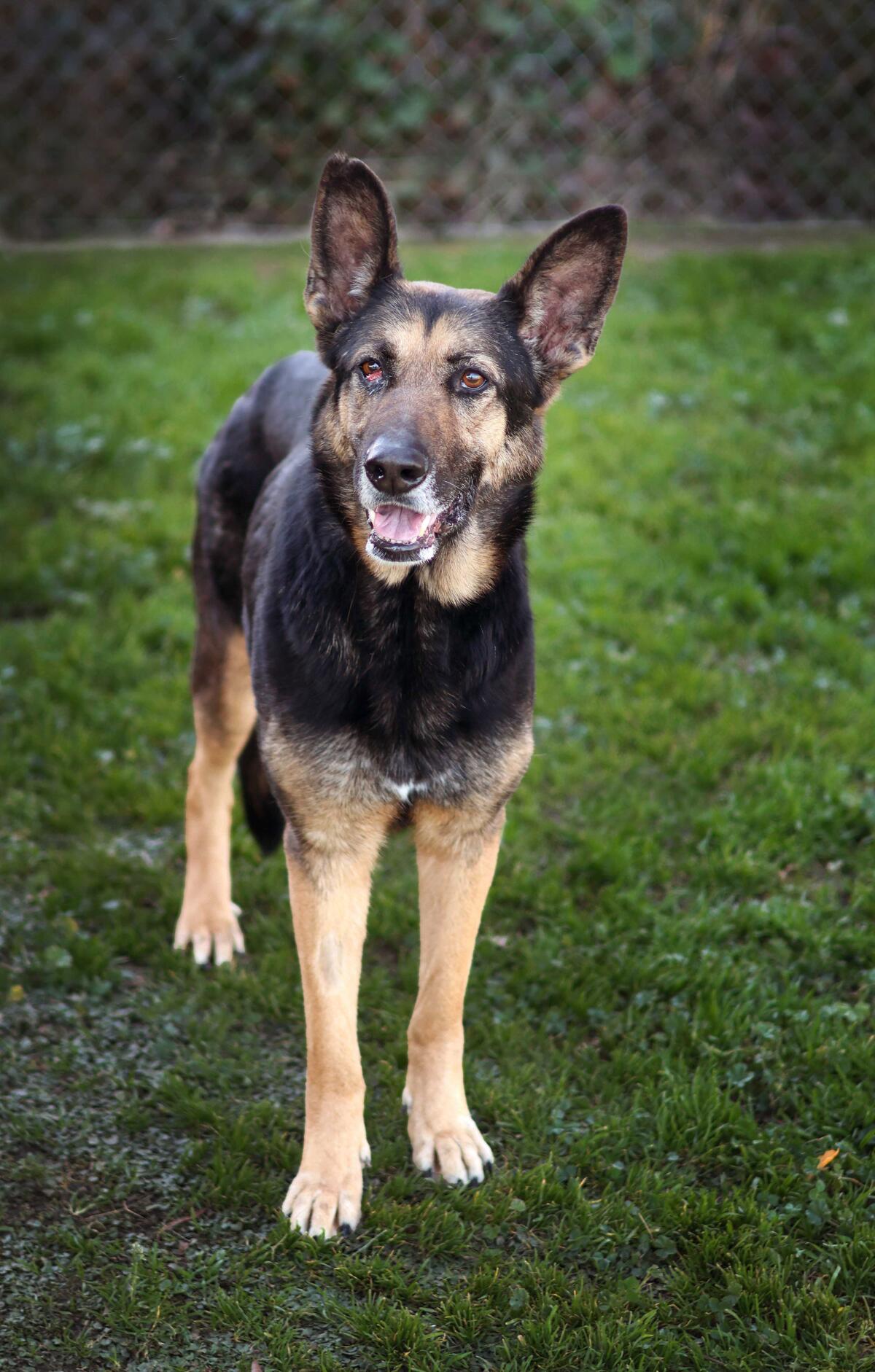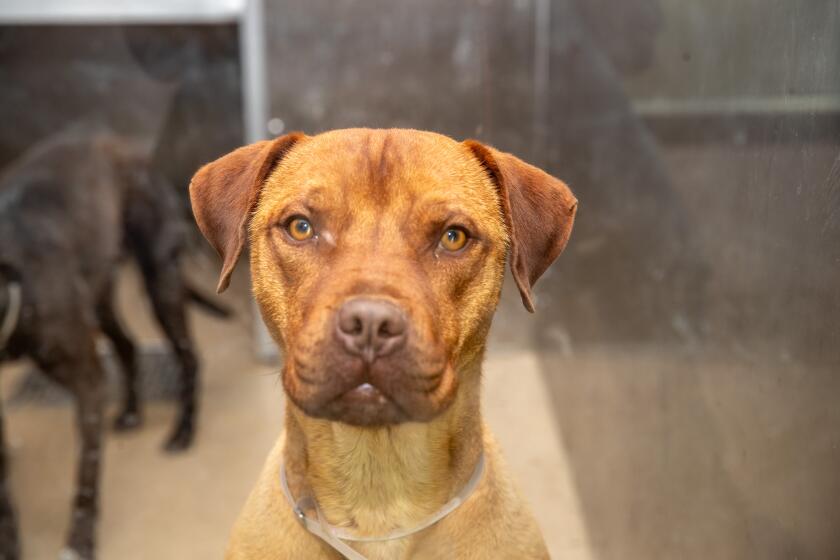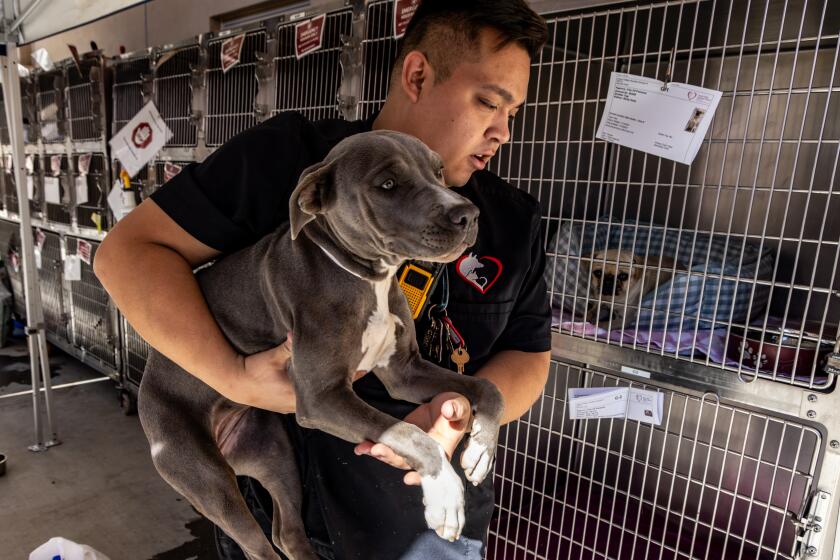Dodger Dog’s plight highlights L.A.’s animal shelter crisis

- Share via
In January, Los Angeles Dodgers pitcher Tony Gonsolin visited a city animal shelter to promote animal adoption. The short video posted to the team’s Instagram account showed the 29-year-old starter holding a cat and shaking hands with a dog while visiting the facility near Dodger Stadium.
But the video didn’t show another pet at the shelter with a closer tie to Gonsolin’s team: a 5-year-old German shepherd named Doddie the Dodger Dog. She got that moniker because she was found abandoned and scrambling around a fence at Dodger Stadium by local residents, who notified animal services.
Time was not on her side. When this article first appeared online, Doddie was scheduled to be euthanized Tuesday unless someone adopted her.
Thousands of dogs are in the city’s care, outnumbering the supply of kennels in the city’s six animal shelters. Overcrowding has been an issue for years, but now multiple large dogs are being held together in some kennels while others sit in cages that line the shelters’ hallways and waiting rooms, according to volunteers and dog rescue groups.
For many volunteers who clean up after animals in the shelters and who take the dogs out for walks, there is a sense that the city’s shelter system will break down unless something new is done.
The county’s Palmdale Animal Care Center was supposed to be a cutting-edge shelter that would relieve overcrowding and reduce euthanasia. But that’s not how it’s turned out.
The Los Angeles Department of Animal Services says that overcrowding has been a growing challenge for nearly two decades “due in part to the department’s long-standing commitment to lifesaving policies.”
During a commission meeting in January 2023, city officials said the shelter staff do not euthanize to make space, but the growing dog population could change that policy. That change has not taken place under the current leadership, and the city still employs a no-kill policy with the goal of saving every “healthy and treatable animal,” according to department spokesperson Megan Ignacio.
The Department of Animal Services “will continue to work to ensure that every healthy and treatable animal in our care is not at risk of euthanasia,” Ignacio said in an email.
There have always been more dogs coming into the shelter system than those being adopted, but a volunteer who has worked in the city’s animal shelters for several years said there’s a lack of transparency with the public about how bad the situation has become.
“The public needs to know that there are too many dogs flooding the system,” said the volunteer, who like the others interviewed did not want to disclose their name for fear of retaliation. “You just can’t keep putting water into a glass. It’s going to overflow.”
At the end of January 2023, the North Central shelter had 228 dogs and 223 kennels or cages. There are now 287 dogs at the shelter. The South Los Angeles shelter had 300 dogs last year and 243 kennels, and at the end of this January there were 456 dogs, according to the latest data from the City Controller’s office.
There were 15 dogs across the six shelters who had not been walked for the last 36 to 42 days, the data show, speaking to the lack of staff needed to keep up with the animals’ daily needs.
Alarmed at the high rate of euthanasia at its two Antelope Valley shelters, L.A. County is moving to add kennels and revisit policies on putting dogs down.
Volunteers take it upon themselves to share videos and photos of dogs up for adoption on social media, separate from the city’s official accounts. Shelters also send out requests to dog rescue groups to help find the dogs a home — but even those groups are finding that there are limited resources.
“Usually, the rescues get very little notice,” said Shira Astrof, co-founder of the nonprofit Animal Rescue Mission. “All of the [volunteer rescue groups] in the network are trying to figure out what to do, because there are no more foster homes left. It’s worse than it has ever been and we can’t adopt our way out of this problem.”
Although the city may pride itself on its commitment to lifesaving policies, many dogs are languishing in crowded, unsanitary shelters, which can lead to them either being traumatized or becoming ill, Astrof said after visiting the city’s South Los Angeles shelter.
“The problem is just going to keep multiplying, because dogs multiply,” Astrof said, emphasizing the need for dogs to be spayed or neutered.
Roughly 23 million people in the U.S. adopted a pet during the pandemic, according to the American Society for the Prevention of Cruelty to Animals. There were 17,213 public adoptions in the city of Los Angeles in 2022, but roughly 42,000 animals remained in the shelter system at the time, including dogs, cats, kittens, rabbits and other animals such as guinea pigs.
Other dog owners acquired their pets from breeders because they wanted specific breeds that were trendy on social media, such as French bulldogs, said Chloe Esperiquette, brand and communications strategist with the nonprofit dog rescue Wags and Walks.
In October, the city council approved a moratorium on issuing new breeding permits in the city, but the ordinance is being drafted by the City Attorney’s Office. At of the end of 2023, there were over 1,800 breeder’s licenses issued in the city, creating a whole separate avenue for people to find a pet.
A lot of dog owners during the pandemic may have turned to a dog for companionship without considering the responsibility.
Responding to high euthanasia rates at animal shelters in Palmdale and Lancaster, volunteers plead with people to stop breeding dogs and causing pets to be surrendered.
“The shelters and the city and volunteers are doing what they can, but they’re busting at the seams,” Esperiquette said. “We’re in a crisis. Over the last eight months to a year it’s gotten worse, and it’s all been going downhill.”
There were 41 people who surrendered their dogs to the city in January who said their landlords enforced a “no pets” policy. An additional 54 said they didn’t have enough time to care for their pet.
In July, Staycee Dains took over as general manager for Animal Services. Through a statement, her office said her administration has “worked urgently to lower overcrowding numbers” and reduce euthanasia rates.
The Department of Animal Services “continues to encourage Angelenos to adopt, foster, volunteer, and donate in order to help the department continue to save the lives of Animals and operate as one of the most humane departments in the country,” the statement said.
A volunteer out of the West Valley shelter said they would support euthanasia where appropriate if it meant providing a humane alternative to warehousing dogs in kennels who are becoming sick and traumatized.
Another volunteer said there’s a real sense of urgency from the city staff to clear out the shelters, but none of that is being relayed to the public.
“It’s like they know we don’t have any place to put them,” the volunteer said. “But no one is acknowledging what’s happening.”
Animal shelters are dealing with an influx of dogs and cats since the pandemic lockdown, and the overcrowded conditions are leading to higher euthanasia rates.
The odds for Doddie the Dodger Dog were especially long. The dog was listed as having major medical issues, and while she was warming up to playing with other dogs, her health was declining in the shelter, according to an Instagram post.
On Sunday, the online listing for Doddie disappeared from the shelter’s website. Ignacio, the spokesperson for the Department of Animal Services, confirmed that she was adopted shortly after The Times reported about her situation.
More to Read
Sign up for Essential California
The most important California stories and recommendations in your inbox every morning.
You may occasionally receive promotional content from the Los Angeles Times.














